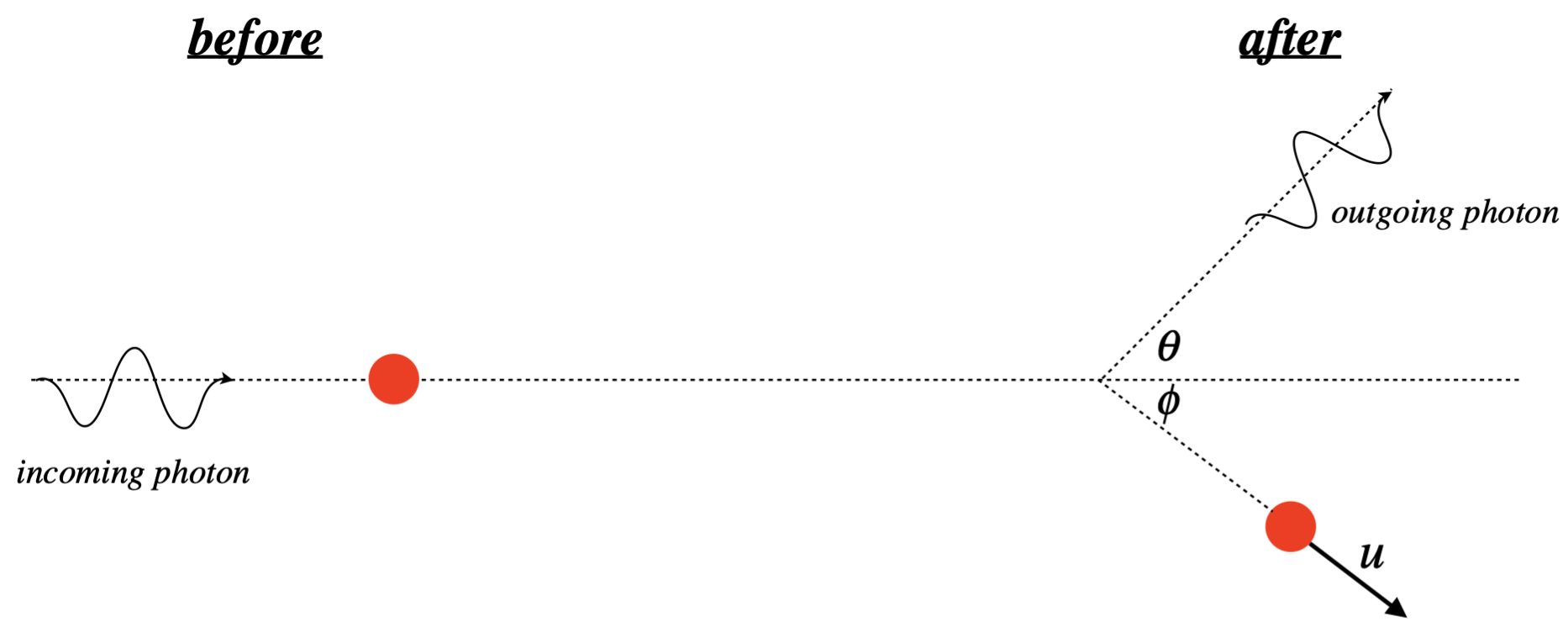5.3: Compton Effect
( \newcommand{\kernel}{\mathrm{null}\,}\)
Scattering
In Physics 9A, we spend some time talking about collisions in two dimensions, such as two billiard balls. Since then, we have learned that to treat these properly for fast-moving, tiny particles, we need to incorporate the corrected momentum from special relativity. We also learned in relativity that light carries momentum. This is not a property typically exhibited by waves, so it seems like studying momentum conservation in collisions between light and matter (called scattering of light off matter) might give us some insight into the new emerging idea from Planck and Einstein that light comes in individual packets with energy equal to hf.
We start with what we found in Equation 4.2.7:
Ephoton=pc
It can be shown that it is not possible for both energy and momentum to be conserved in the case of a free particle, but if the photon scatters off the electron, these conservation laws can be obeyed. Of course, the photon will in general give some of its energy to the particle, so the resulting scattered photon is not really the same photon as before (it has a different frequency!). A before/after picture of the event is helpful:
Figure 5.3.1 – Photon Scatters off a Particle

There is of course no reason to make this calculation more difficult than it needs to be, so choosing the "lab frame" (reference frame where the target particle is at rest) makes sense.
Just when a collision between a photon and an electron appears to be just like a collision between two billiard balls, the photon remembers that it is also a wave! If a cue ball collides with an eight ball, after it bounces off, it doesn’t become a different ball, but a photon loses some of its energy (given to the electron), so since E=hf, its frequency goes down! In other words, the photon that leaves the collision is a totally different photon from the one that came in!
Compton Wavelength
Using the figure above, we can invoke momentum and energy conservation to relate the change in the photon's wavelength as a function of the scattering angle theta. Calling the momentum of the incoming photon pin, the momentum of the outgoing momentum pout, and using the relativistic momentum for the particle, we have the following two conserved momentum components:
x-direction:pin=poutcosθ+γumucosϕy-direction:0=poutsinθ−γumusinϕ
We can also have energy conservation at our disposal. The energy of the photons satisfy E=pc, and the particle initially has only it's rest energy, so:
pinc+mc2=poutc+γumc2
After much algebra to eliminate the angle phi from the simultaneous equations, the result is:
1pout−1pin=1mc(1−cosθ)
We can take this a step further and compare the incoming and outgoing photon wavelengths, by using Planck's equation for the relationship between photon energy and frequency:
Ephoton=pc=hf=h(cλ)⇒p=hλ
Putting this in above gives:
λout−λin=hmc(1−cosθ)
Let's take a moment to interpret what this means. We shine light of a known wavelength into a cloud of stationary particles (say electrons), and we measure the wavelengths of the light that come out at the various angles. From this data we can determine the mass of the particles in the cloud. The quantity hmc is often written as "λc", and is called the Compton wavelength of the particle with mass m. Notice that the most energy that the photon can lose is when it is backscattered, i.e. when it comes straight back the way it came in. In this case, cosθ=cos180o=−1, which means that the wavelength of the incoming light is increased by two Compton wavelengths.
Another thing to note is that if the scattering is off a heavier particle (such as a proton rather than an electron), then the effect is far less pronounced, meaning the scattered light is closer in wavelength to that of the incoming light than if the particle were lighter. This makes sense, since heavier particles will take less of the photon's energy than lighter ones, so the outgoing photon energy will be closer to the incoming photon energy. A common way of stating this is to say that if the wavelength of the light is much greater than the Compton wavelength of the target particle, then the scattered light experiences a negligible wavelength shift compared to the incident light.


